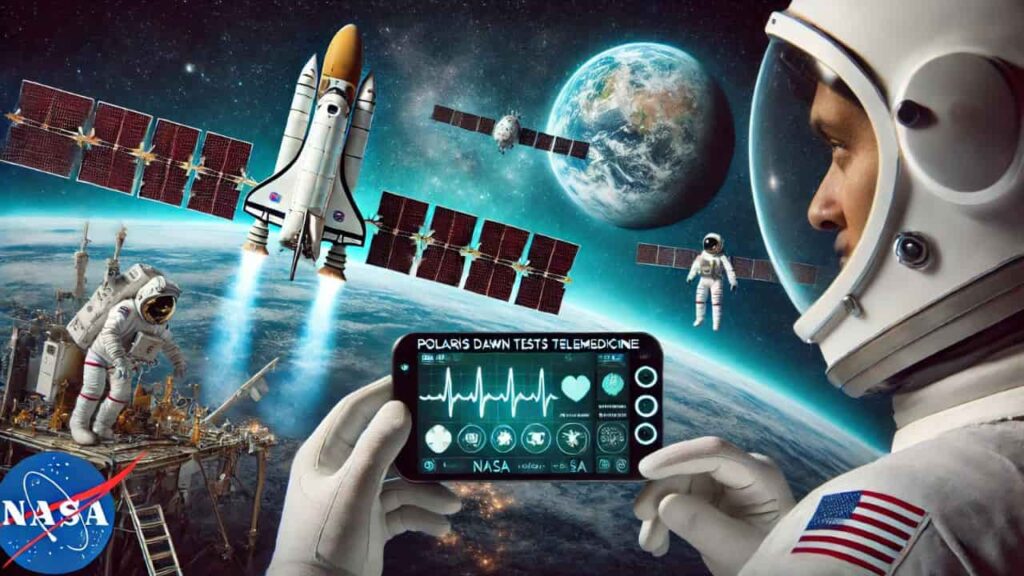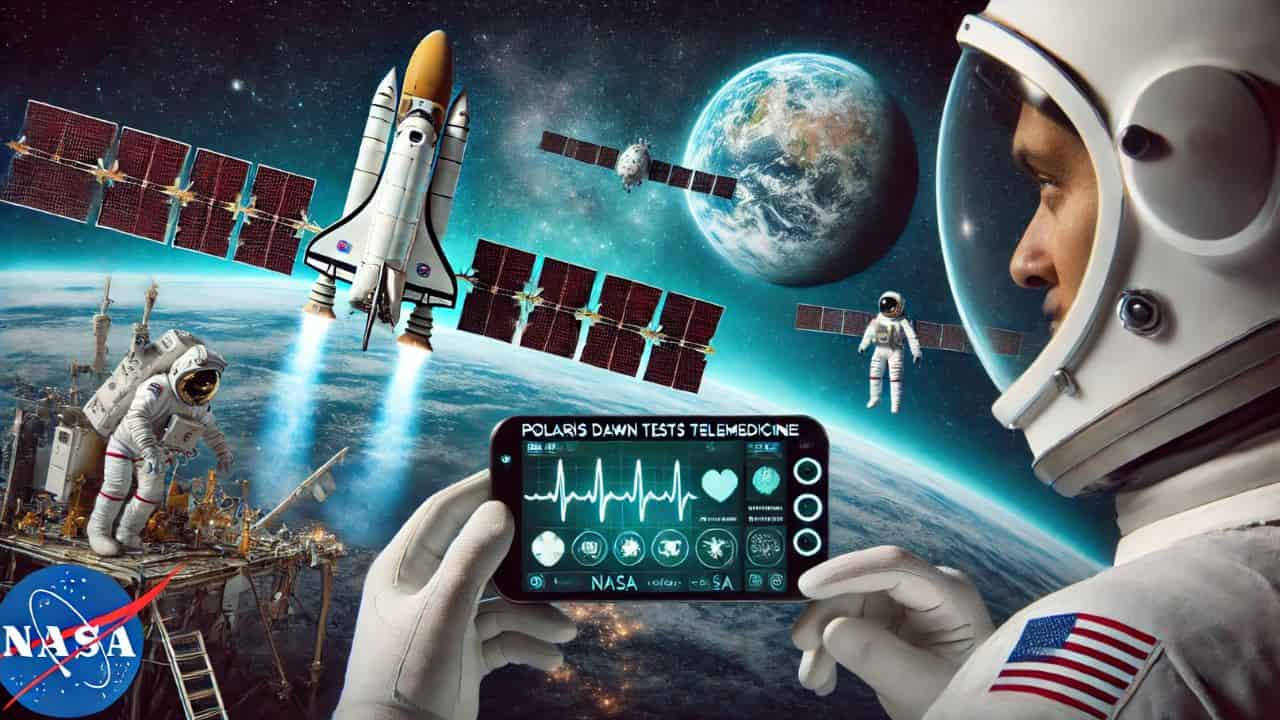NASA, Polaris Dawn, telemedicine, space health, space exploration, Jared Isaacman, SpaceX Dragon, Falcon 9, astronaut health, human research, space motion sickness, Moon missions, Mars missions
Discover how NASA’s Polaris Dawn mission is testing telemedicine and gathering essential health data for future space missions to the Moon, Mars, and beyond. Learn about the innovative technologies and research aimed at protecting astronaut health during deep space travel.

NASA to Test Telemedicine and Gather Essential Health Data with Polaris Dawn Crew: A Milestone in Space Exploration
NASA researchers are preparing for an exciting phase in space exploration, as the agency’s Human Research Program embarks on a groundbreaking experiment with the Polaris Dawn mission. This mission, launched aboard SpaceX’s Dragon spacecraft and Falcon 9 rocket, aims to gather critical health and medical data that will benefit future long-duration space missions to the Moon, Mars, and beyond. Telemedicine, a crucial aspect of healthcare delivery in space, will be one of the highlights of this mission, as the Polaris Dawn crew conducts experiments to assess health risks, performance, and new medical approaches in space.
This fully-commercial spaceflight mission represents a significant step toward NASA’s long-term goal of exploring deeper into space while maintaining astronaut health. The Polaris Dawn crew includes four members: Jared Isaacman, Scott “Kidd” Poteet, Sarah Gillis, and Anna Menon. These individuals are not just flying in space but are actively involved in scientific research, testing technologies that could revolutionize healthcare and astronaut performance during future space explorations.
NASA’s Human Research Program: The Core of Space Health Innovation
NASA’s Human Research Program (HRP) is at the forefront of studying how spaceflight affects human bodies and behaviors. The program’s objective is to identify the best methods and technologies to support astronauts’ safe and productive human space travel. To do this, NASA collaborates with various commercial missions, including Polaris Dawn, and conducts research in laboratories, ground-based analogs, and the International Space Station.
For decades, NASA scientists have focused on understanding the complex relationship between space conditions and human health. The space environment is harsh and poses risks such as microgravity, space radiation, and isolation. These factors can affect physical and mental well-being, and NASA’s research aims to address these challenges to ensure the safety of astronauts as space exploration progresses.
One of NASA’s major concerns is how the human body reacts to long-term exposure to space conditions. Prolonged space missions, such as those planned for the Moon and Mars, will expose astronauts to various health risks. These include muscle and bone loss due to microgravity, space motion sickness, cognitive impairment, and mental stress. NASA’s HRP continues to conduct experiments to find innovative ways to protect and enhance astronauts’ health and well-being.
The Polaris Dawn Mission: A Platform for Vital Research
The Polaris Dawn mission offers a rare opportunity for NASA scientists to conduct vital human health research in space. The four-member crew will participate in numerous health studies and experiments throughout their mission, contributing valuable data to NASA’s HRP.
One of the key objectives of the Polaris Dawn mission is to test and validate telemedicine technology, which could prove essential for future deep space missions. Telemedicine allows for remote diagnosis and treatment of medical conditions, enabling astronauts to manage their health more effectively without constant direct communication with Earth. This technology will be crucial as astronauts venture further into space, where communication delays may make it impossible to rely on immediate medical guidance from Earth.
To achieve this, the crew will test a commercial device capable of collecting and integrating vital health measurements, including blood pressure, heart rate, respiration rate, and body temperature. This device also features ultrasound imaging, video camera capabilities for larynx and throat examinations, and an experimental telemedicine feature. By comparing the data from this device with traditional health monitoring methods, NASA aims to validate telemedicine’s effectiveness for real-time diagnosis and treatment in space.
Another crucial experiment on the Polaris Dawn mission focuses on space motion sickness, a condition experienced by many astronauts. Space motion sickness occurs due to the lack of gravity, which disrupts the body’s vestibular system responsible for balance and orientation. Crew members will document their symptoms and explore various interventions to alleviate discomfort. This data will help NASA develop countermeasures for space motion sickness, ensuring astronauts remain mission-ready.
Additionally, NASA researchers are keen to understand the risks of flight-associated injuries, particularly during re-entry into Earth’s atmosphere. The Polaris Dawn crew will undergo post-flight assessments to document any injuries or discomfort experienced during re-entry. This information, combined with data from sensors aboard the spacecraft, will allow NASA scientists to analyze the spacecraft’s dynamics and landing loads, providing insights into how to mitigate potential injuries during future space missions.
Telemedicine: A Key to Future Space Missions
Telemedicine has long been considered a vital component of space exploration, particularly as missions to the Moon, Mars, and beyond become longer and more isolated. On Earth, telemedicine has transformed healthcare delivery by providing remote consultations and diagnoses, especially in rural and underserved areas. In space, telemedicine can bridge the gap between astronauts and medical experts on Earth, allowing crew members to manage their health autonomously.
During the Polaris Dawn mission, the telemedicine feature will rely on SpaceX’s Starlink communications system to connect the crew with healthcare professionals on Earth. The crew will simulate medical scenarios where the telemedicine device offers diagnoses based on crew inputs and available documentation. If successful, this technology could revolutionize healthcare in space, ensuring that astronauts have access to medical expertise even during long-duration missions far from Earth.
As NASA prepares for missions to the Moon and Mars, telemedicine will play a pivotal role in managing astronauts’ health. Communication delays, which can range from a few seconds to several minutes, will be a significant challenge for future missions. Telemedicine will enable astronauts to receive timely medical assistance without the need for immediate communication with Earth, making them more self-reliant and prepared for potential medical emergencies.
TRISH and NASA’s Collaborative Research: Expanding Our Knowledge of Space Health
NASA’s partnership with the Translational Research Institute for Health (TRISH) adds another layer of scientific inquiry to the Polaris Dawn mission. TRISH is a NASA-funded consortium of academic institutions dedicated to advancing human health research in space. Through this collaboration, Polaris Dawn will set a new baseline for collecting standard health data on commercial spaceflights.
The TRISH studies will focus on how spaceflight affects mental and physical health, with crew members undergoing a battery of medical tests and scans before, during, and after the mission. These tests will assess various aspects of astronaut health, including cognitive function, behavior, sleep patterns, bone density, and eye health. The data collected from Polaris Dawn will complement the datasets routinely gathered from NASA astronauts, providing a broader understanding of how commercial spaceflight impacts human health.
This collaboration underscores the importance of long-term health monitoring for astronauts. By analyzing data from multiple space missions, NASA can develop strategies to mitigate the health risks associated with space travel, ensuring that astronauts remain healthy and mission-ready for extended periods.
Future Implications: Preparing for the Moon, Mars, and Beyond
The health data gathered during the Polaris Dawn mission will have far-reaching implications for future space exploration. NASA’s Artemis program aims to return humans to the Moon by the late 2020s, with the ultimate goal of establishing a sustainable presence on the lunar surface. Beyond the Moon, NASA envisions sending humans to Mars, a mission that will require astronauts to spend months or even years in space.
To achieve these ambitious goals, NASA must ensure that astronauts can maintain their health and performance during extended missions. The telemedicine technology tested on Polaris Dawn could become a staple of future space missions, allowing astronauts to manage their health autonomously and providing them with real-time medical support when needed.
As NASA continues to push the boundaries of space exploration, research on astronaut health will remain a top priority. The insights gained from the Polaris Dawn mission will not only inform future space missions but also contribute to the development of medical technologies that could benefit healthcare on Earth.
Conclusion: Polaris Dawn – A Gateway to Deeper Space Exploration
The Polaris Dawn mission marks a significant milestone in NASA’s quest to ensure the health and safety of astronauts during long-duration space missions. Through its innovative telemedicine experiments, health monitoring technologies, and collaboration with TRISH, the mission is setting the stage for future space exploration to the Moon, Mars, and beyond.
As we look to the future, the research conducted on Polaris Dawn will play a critical role in advancing space health science. By gathering essential health data and testing new medical technologies, NASA is ensuring that astronauts are well-prepared for the challenges of deep space travel.
Read More
- NASA and Sierra Space Dream Chaser Arrives in Florida for Launch Prep
- SpaceXs New Falcon 9 Booster Successfully Launches 22 Starlink Satellites Boosting Global Connectivity
- Everything You Need to Know About the Full Sturgeon Moon 2024 August Supermoon Viewing Guide
- NASA and Northrop Grummans 21st Resupply Mission to ISS: Launch Details and Scientific Highlights










